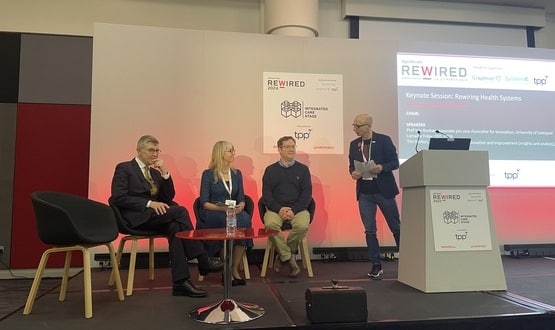Lessons from Covid – what has worked and what hasn’t
- 11 August 2020

The Digital Healthcare Council’s members have mobilised at unprecedented scale to support the NHS and social care in their response. Its director, Graham Kendall, outlines what has worked, and what needs to change.
It is increasingly clear that there will not be an immediate return to normal after Covid.
Without a game-changing medical breakthrough implemented in the near future, the next phase will bring profound changes and will last well into 2021. If we are to move forward, we will need to learn some key lessons from the past few months.
A potentially lethal mix of backlogs and reduced capacity
Despite the surge in remote appointments and online consultations, we know that the total number of appointments and care episodes have dropped substantially since March – GP appointments down by a third and hospital admissions plummeting to just 15% of last year’s levels. It is therefore inevitable that there is a growing backlog of demand that we will count in millions, not thousands.
In normal times we would tackle a backlog by ramping up capacity, but the next phase will continue to entail social distancing in healthcare, slower processes to incorporate PPE and squeezed staffing availability. In turn, health service capacity will be reduced, affecting everything from waiting times through to day-to-day management of chronic conditions. Even without a second wave, this is the immediate reality for the foreseeable future.
For those waiting longer, this means more pain and discomfort, conditions worsening without treatment, and yes, for some, it may shorten their lives.
Digital health is one of the most innovative and competitive sectors in the world
No single organisation has a monopoly on innovation, though undoubtedly some are better at it than others. It follows that we need to make the most of everyone’s expertise.
In the months before Covid, the centre emphasised the importance of creating a rich and diverse supplier community, rather than imposing top-down solutions. That means open tenders, transparency and integration. Although that was undoubtedly the right approach, we have since seen several rushed procurements that have led to unintended consequences and distrust from the markets. For example:
- A single closed procurement for secondary care outpatient appointments that sent shockwaves through the industry.
- Pricing that advantaged single feature providers rather than more establish companies who can provider a fuller service. A level playing field requires fair pricing to support value across care. This is a win-win as patients, healthcare services benefit and it is the best way to ensure digital providers can continue to scale up. These are the future of UK PLC.
- Bullish attempts to own all IP.
- Confusion around the consistent implementation of standards from arms-length bodies such as the CQC, NHSX and MHRA.
We have also seen surprising duplication, with the centre attempting to replicate what has already been developed elsewhere, but with reduced capability.
Video consultations are essential, but just the start
There has been a lot of discussion recently about the merits of video compared to other channels such as text or telephone consultations. This misses the point: it’s like debating whether a stethoscope or a thermometer is more important, while ignoring the growing queue of patients. Clearly visual contact is preferable in many circumstances, but this will only succeed if it works for patients, embeds ongoing support and communication that embraces all channels.
Video should be the bedrock of the remote experience, integrated with face-to-face provision where required. Some will choose telephone consultations, especially in cases of digital exclusion, but underpinning it all is the wider integration necessary to give patients access to ongoing support and monitoring, linked into records and to ensure that all patients are connected with the right expert clinicians at the right time. Add in digital triaging and insights from deep analytics and we really start to get somewhere.
By contrast, when we see new mass call handling services staffed by people with minimal training to signpost people with Covid symptoms, it is hard not to conclude that we could have achieved much more through a smart digital-first solution.
Although we have seen rapid procurement at scale in recent months, the focus on low-cost point solutions risks fragmenting the benefits we could achieve. The combined result is that much innovation is simply not available to end users. The phrase ‘penny wise, pound foolish’ springs to mind.
At the same time, the lack of published data has thrown a cloak of opacity over progress. Even where we collect data centrally, i.e. directly from providers on video consultations, we are yet to see systematic publication. That transparency is vital if we are to make informed decisions in the future.
Digital Healthcare Council members are experts in bringing together these services and many of their NHS partners have chosen to work directly with them to develop enhanced integrated solutions rather than use national contracts. They recognise the value – and are willing to pay for – a more integrated service even though there are nationally provided point solutions.
We have standards for a reason
All healthcare is risky. That is why we innovate in the context of robust regulations.
Regulations need to keep pace with developments and a key part of that is that we need consistency across regulators and their regulations. Just as we need consistency in approach for online prescribing between the CQC and the GpHC, we need procurements to follow existing regulatory requirements.
Privacy standards, CE marks and rules around testing, to name just some, all exist for a reason. Discarding them, or interpreting them in contradictory ways, risks locking ourselves into approaches that fail to meet the needs of clinicians and patients. Moreover, jeopardising key regulatory standards in procurement may inadvertently expose NHS organisations and even individuals to legal challenge.
On testing, we see the same rule being interpreted differently for home tests for Covid compared to HIV. This jeopardises the development of new solutions and crucially denies services to patients and the public.
Key lessons
The lessons the Digital Healthcare Council draws from these experiences are that procurements should:
- Focus on integrating solutions – prioritising and enhancing the user experience, rather than bulk buying commoditised siloes. We do this best when tenders define the problem allowing providers to propose and implement a range of solutions.
- Support and empower local users to choose solutions that work for them. This means making information available, devolving down decision making (and money), and supporting a diverse range of suppliers. Top-down monopolies and state-sponsored first mover advantage rarely breed vibrant innovative communities.
- Avoid spending money twice – if a local service wants, and is willing to pay for, a more integrated solution, then allow them to use funding that would otherwise be made available for point solutions. For example, a local service should be allowed to use funding for video point solutions to go towards paying for a more integrated service that includes video.
- Comply with regulatory standards – including CE marks, privacy standards – and implement those standards consistently.
- Require and publish data on utilisation and quality metrics.
Eight years since the formation of a digital function within NHS England, and with all incarnations of leadership saying they have ‘learnt the lessons of Connecting for Health’, we see too many examples of a return to top-down closed, proprietary, centralised solutions being dictated on the NHS from a central function, with little local freedoms to spend budget as they see fit.
If we are to avoid being overwhelmed by the challenges we face from Covid, we must rediscover the vision and ambition of a thriving digital ecosystem.




